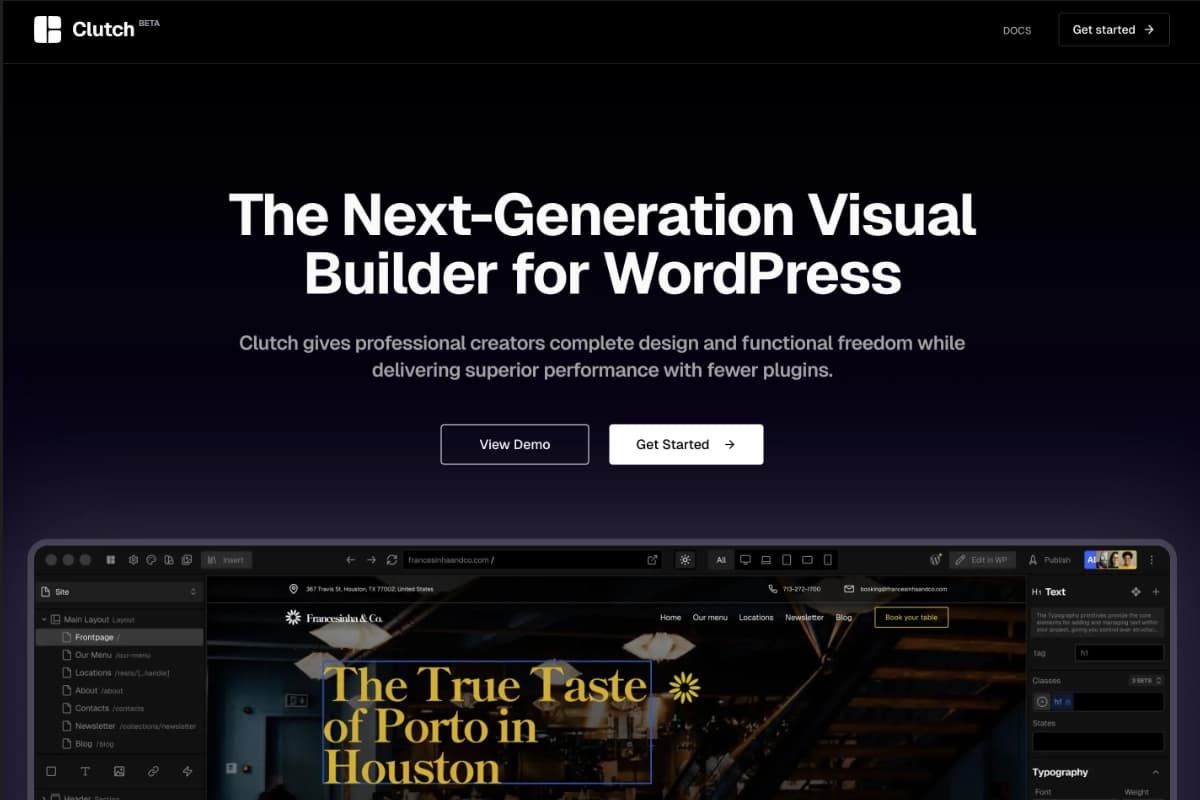Clutch Page Builder for WordPress: A Headless Dev’s Surprise Gift

What can I say—wow. Where did this come from?
After months of deep-diving into headless WordPress and Next.js—mapping routes, wrangling ACF fields, and generally losing sleep over SSG—I stumble upon Clutch Page Builder, a tool seemingly built just for this setup.
A visual builder for headless WordPress + Next.js? Yes please. Let’s break this down.
Headless WordPress Ain’t for the Faint of Heart
If you’re used to monolithic WordPress, going headless feels like switching from IKEA furniture to raw lumber. You lose a lot of the “it just works” magic—and suddenly, you need to know what a route is. And how to build one. And how to name it. And why it’s yelling at you.
Routes
In monolithic WordPress, routes (aka pages/posts) just sort of… exist. In Next.js, you make them. Each route corresponds to a folder, and inside that folder lives a page.tsx file. You want /about? That’s a folder. You want dynamic blog posts? Now you’re writing [slug]/page.tsx and wondering if this is what raw dogging feels like.
Data Structure
If you want a non-dev to edit a page, you better plan ahead. That means structuring your content in WordPress—using something like ACF—so it can be fetched by your Next.js frontend via REST API. Otherwise, every copy change involves a Git commit. And no non-technical contributor wants that.
SSG & ISR
Next.js ships with Static Site Generation (SSG) and Incremental Static Regeneration (ISR). Translation: you can build static pages for performance, and selectively rebuild them in the background when content updates. It’s like having your cake, serving it from a CDN, and quietly baking a new one behind the scenes.
Media
You can use media locally in your Next.js public folder or pull it in via the WordPress REST API. Either way, wrap it in Next.js’ <Image /> component and let it handle the performance wizardry.
SEO
SEO isn’t a plugin anymore—it’s your job. Use Next.js metadata functions to set dynamic page titles and meta descriptions. Pull Yoast SEO data from the API if you’re fancy, or hard-code like it’s 2009.
Sitemap & robots.txt
Yep, you’re building those too. Pro tip: you can generate them with a little TypeScript and a lot of patience.
Enter: Clutch Page Builder
And just when you’ve wrapped your head around all that complexity… Clutch enters the chat.
Clutch is a visual page builder designed specifically for headless WordPress setups using Next.js. It’s built to play nice with Tailwind, ACF, and Vercel. In other words, it’s here to take some of that heavy lifting off your plate.
No more manually connecting every field. No more endless mapping and config files. Clutch promises:
- Visual site-building interface
- Seamless WordPress + ACF integration
- Tailwind-ready component output
- Built-in support for TypeScript and Next.js best practices
It’s still in beta, but from what I’ve seen so far, it’s shaping up to be a big deal.
What I Hope It Nails
If there’s one thing I’m cautiously optimistic about, it’s interface flexibility. Page builders often come with guardrails—which is great until you want to step over them. Sometimes I just want to slap on a Tailwind class and move on with my life, not fiddle with ten drop-downs for padding.
Ideally, it would be great if Clutch lets you:
- By pass the CSS controls and get down and dirty with your own CSS. Even if it’s extending Tailwind.
- Import your own code for your own components.
- Play nice with WordPress, so that anything added is easy to update, so that none technical people can still build out content in WordPress.
- One impressive feature I saw from an upcoming builder, Etch, is one to one components with Gutenberg. Something like this would be great here also.
If it can balance flexibility with usability, then I think we’ve got a real winner on our hands.
TL;DR
- Headless WordPress + Next.js is powerful, but complex.
- Clutch Page Builder is trying to make it easier with a visual, ACF-integrated, Tailwind-friendly builder.
- Still in beta, but worth keeping a close eye on.
- I’ll be testing it out more soon—stay tuned for part two.